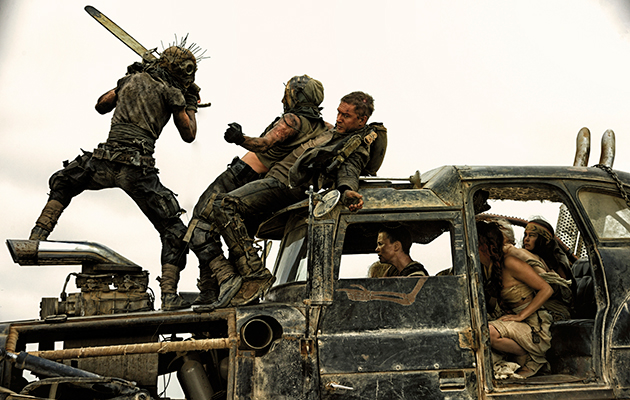Last year, Uncut asked Jimmy Page what his best non-Zeppelin accomplishment was to date. It transpired that second in Page’s list of crowning achievements – after the mighty Zep, of course – was standing on top of a double decker bus playing “Whole Lotta Love” at the Closing Ceremony of the 2008 Beijing Olympics. That scene is partly recreated in George Miller’s revamped action franchise: one preposterously decorated truck has a lead guitarist perched on the hood, blasting out an endless succession of riffs in front of a stack of amplifiers. It says much about George Miller’s creative vision that this is simply a minor spectacle in amidst the ridiculous, hugely implausible and bizarre cacophony the director whips up. If there is a message to Miller’s film – the first Mad Max film in 30 years – it is simply that the highways of Valhalla are littered with radioactive dust storms, inbred feral militia and two-headed lizards.

In case you thought Miller might have quietened down a little now he’s 70 years old, you would be much mistaken. Mad Max: Fury Road is a heavy metal fantasia so heavy and so metal, the credits are in molten red lettering. Admirers of the Max films, then, will be gratified that nothing much has changed since last we visited Miller’s post-apocalyptic wasteland. Petrol, water and bullets are still the principal currencies while outrageously pimped automobiles remain the main mode of transport. The denizens also largely retain their semi-bestial qualities; in this case, many of them can be found living in Citadel, a canyon stronghold ruled by fierce warlord Immortal Joe (Hugh Keays-Byrne). With his body marked with queasy-looking pustules, his mouth covered in a ventilator mask branded with a skull emblem and a shock of long white hair, Joe looks every inch the unreasonable tyrant. As you’d imagine, Joe is pretty narked when he learns that five of his “breeders” – impossibly beautiful women he has taken as his wives – have been smuggled out of Citadel by Impirator Furiosa (Charlize Theron), one of Joe’s principal allies who has turned rogue. Joe dispatches his shaven-headed, chalk-white Warboys in pursuit: a freakish convoy of heavily armed and nightmarishly decorated vehicles.
Into this thunderously loud set-up comes Max Rockatansky (Tom Hardy) – “a crazy smeg eats schlinger”, whatever that may be. The former cop turned scavenger, Max forms an alliance with Furiosa, her cargo and Nux (Nicholas Hoult), a Warboy with an unusual connection to Max. They spend the best part of two hours thundering one way across the desert being pursued by Joe and his goons, then the other way. As you’d expect, vehicles get blown up in the most inventive manner possible. Indeed, Mad Max: Fury Road is a remarkable achievement for Miller. It is hard to tell where stunts and real traffic end and CGI begins. In a movie culture dominated by green screen work, Miller’s long takes and handcrafted feel offer a palpable sense of detail to the action. Credit in particular is due to Brendan McCarthy, the comic book artist and Miller’s chief collaborator here, who has essentially been finessing his pitch for Max since 1983’s post-apocalyptic surf comic, Freakwave. Indeed, fans of that series might have hoped for a cameo from Mickey Death in Fury Road; alas, it was not to be. As it is, McCarthy’s remarkable work is evident in the outlandish production design. The film looks fantastic, too: shot by cinematographer John Seale in a rich Technicolor, giving the desert (Namibia doubling for the Outback) rich, orange hues. The editing and sound design – never admittedly by most pressing concerns in a film – are top-notch here.

Hardy, in some respects, offers up a variation on the character he played in Locke: another man in transit and in crisis. Hardy – never knowingly shy of an accent – gives Max a gruff broque, which sounds sort of like Richard Burton doing an especially fruity impression of an Australian. Although Max is required to do little more than drive, look sullen, drive, shoot people, drive some more, Hardy brings a craggy, impassive quality to the part; he is a far more brooding figure than Mel Gibson in the original films. Theron, meanwhile, does equally staunch work as the righteous and strong-willed Furiosa. But characterisation (and indeed dialogue) is secondary to the stunts and the transport. For all its futuristic gallimaufry, Mad Max: Fury Road has noticeably old-fashioned antecedents – this is a straight update of a western, with Furiosa’s beleaguered 18-wheeler replacing the stagecoach and the Warboys analogous to a tribe of pursuing Red Indians.
Essentially, the film is a remarkable achievement for George Miller, who should really be looking forward to putting his feet up rather than charging round Africa with several hundred souped-up cars of various delineation. It is far more fun than any other action movie in recent memory; and no doubt a sweet vindication for Miller’s admirable perseverance.



